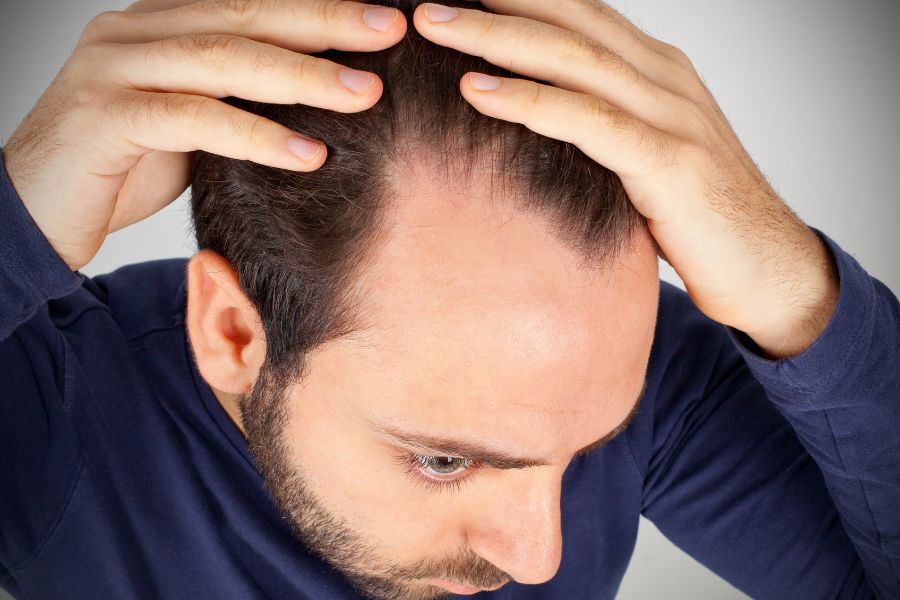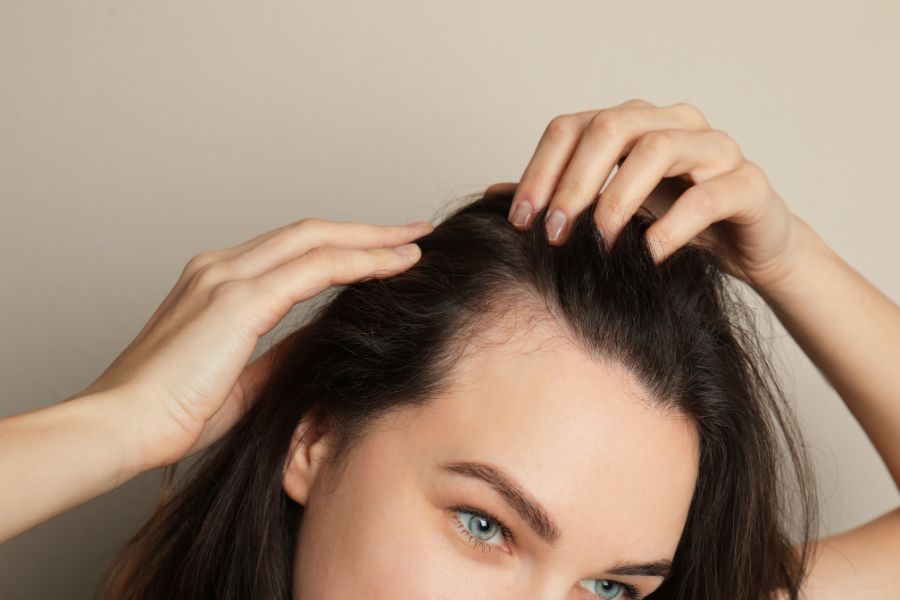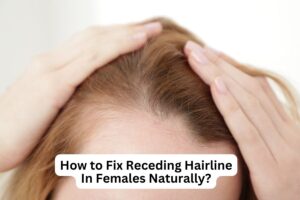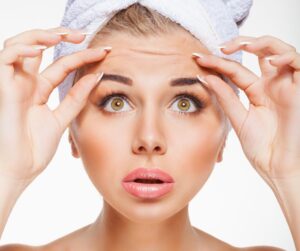Mature hairline vs receding hair—these terms are often heard in conversations about hair loss, but what exactly do they mean? Understanding the difference between a natural maturation of the hairline and a receding one is crucial for anyone concerned about their hair’s appearance. In this comprehensive guide, we will delve deep into these distinctions, providing you with expert insights to demystify the topic.
Are you experiencing changes in your hairline and wondering if it’s a sign of maturity or something more? Stay with us as we unravel the complexities, leaving you with a better understanding of your unique situation. Prepare to be enlightened and gain the knowledge you need to make informed decisions about your hair health.
Check out our latest posts;
- Menopause Frizzy Hair Treatment: Effective Solutions for Smooth Hair
- Sore Nails After Acrylics Removed: What You Need to Know
- Paper Thin Nails After Acrylics: Understanding Causes and Remedies
- Mature Hairline VS Receding Hair: Understanding the Difference
- Toothpaste on Pimples Overnight: Does It Work?
What is a mature hairline?
A mature hairline is a natural part of the aging process, signifying a subtle shift in the hairline’s position during early adulthood. Unlike receding hairlines, it involves a slight recession at the temples, creating a more rounded shape at the front.
- Natural Process: A mature hairline is common and genetically predetermined, affecting both men and women.
- Subtle Recession: It involves a slight backward movement at the temples, not a drastic loss of hair.
- Typically Early Adulthood: This change often occurs in early adulthood and stabilizes over time.
- Different from Hair Loss: Unlike receding hairlines, it doesn’t signify significant hair loss but is a natural and gradual transition.
- Embracing Change: Recognizing a mature hairline as a natural part of aging can promote confidence and self-acceptance.
Related: Homemade Sea Salt Hair Spray
What is a receding hairline?

The term “receding hairline” refers to a common hair loss pattern characterized by the gradual thinning and backward movement of the hairline on the scalp. This process, often seen in men as they age, can also affect women. Understanding the features of a receding hairline is crucial for those concerned about hair loss and seeking ways to address it effectively.
- Gradual Thinning: A receding hairline involves the progressive thinning of hair around the temples and forehead.
- M-shaped Pattern: Hair loss typically forms an M-shaped pattern, with the hairline receding from the temples and creating a widow’s peak.
- Genetic Predisposition: Genetic factors play a significant role in determining the likelihood of developing a receding hairline.
- Hormonal Influence: Hormonal changes, particularly dihydrotestosterone (DHT) levels, contribute to hair follicle shrinkage and eventual hair loss.
- Age-Related: While it often starts in middle age, a receding hairline can occur earlier, leading to self-consciousness and concerns about appearance.
- Treatment Options: Various treatments, such as medications, topical solutions, and hair transplant procedures, can help manage and restore hair in the affected areas. Seeking professional advice is essential for effective solutions.
Related:
- How to Make Your Hair Less Poofy Naturally; 7 Killer Tricks To Tame It
- What Are the Best Vitamins for Thicker Hair?
The distinction between a mature hairline and a receding hairline
Understanding the subtle yet significant differences between a mature hairline and a receding hairline is pivotal for anyone grappling with concerns about their hair. Here’s a breakdown of the key distinctions between these two hairline patterns:
Mature Hairline:
- Natural Aging Process: A mature hairline is a normal, genetically predetermined phase of aging, occurring in early adulthood.
- Slight Recession: Involves a subtle recession at the temples, creating a more rounded shape at the front of the hairline.
- Stabilizes Over Time: The hairline typically stabilizes, causing no further drastic changes as one ages.
- Common and Acceptable: Widely accepted as a natural part of growing older, a mature hairline is not typically a cause for concern regarding hair loss.
Related:
- The way to make a stable hair conditioner bar
- Regrow Hairline; Is It Possible? How To Stop Receeding Hair?
Receding Hairline:
- Gradual Thinning: A receding hairline involves gradual thinning and backward movement of the hairline on the scalp.
- M-Shaped Pattern: Hair loss forms an M-shaped pattern, starting around the temples and creating a widow’s peak.
- Hairline receding can be caused by a family history of the condition and hormonal imbalances, especially high levels of dihydrotestosterone (DHT).
- Age-Related and Concerning: This typically starts in middle age but can occur earlier, leading to self-consciousness and concerns about appearance.
- Various Treatment Options: Management of a receding hairline may involve medications, topical solutions, or hair transplant procedures, depending on the severity. Seeking professional guidance is essential for suitable treatment choices.
Recognizing the dissimilarities between these two hairline patterns empowers individuals to make informed decisions about their hair health and adopt appropriate measures to address their specific concerns. Consulting with experts can provide tailored solutions, promoting confidence and a positive self-image.
My hairline is receding; how can I stop it?

Facing the distressing reality of a receding hairline often prompts the question, “My hairline is receding; how can I stop it?” Many people who are looking for practical solutions to maintain their hair and boost their confidence share this concern. Addressing a receding hairline involves understanding its underlying causes and implementing appropriate strategies to slow down or potentially halt the progression. Here are key points to consider when trying to stop a receding hairline:
- Identify the Cause: Understanding the root cause of your receding hairline is essential. Factors like genetics, hormonal imbalances, stress, and certain medical conditions can contribute. Consulting a healthcare professional or a dermatologist can help pinpoint the exact cause in your case.
- Maintain a Healthy Lifestyle: Adopting a balanced diet rich in essential nutrients, regular exercise, and proper sleep can contribute to overall health, including hair health. Nutrients like biotin, zinc, and vitamins A and D are particularly beneficial for hair growth.
- Avoid Harsh Hair Treatments: Limit the use of harsh chemicals, heat styling tools, and tight hairstyles that can damage hair follicles and exacerbate hair loss. Opt for gentle hair care products and hairstyles that don’t put excessive strain on your hair.
- Consider Hair Growth Treatments: Over-the-counter treatments containing minoxidil, a topical medication, have been proven to slow down hair loss and promote regrowth for some individuals. Prescription medications, like finasteride, can also be effective in certain cases.
- Explore Platelet-Rich Plasma (PRP) Therapy: PRP therapy involves injecting your own concentrated blood platelets into the scalp, stimulating hair follicles, and promoting hair growth. This non-invasive treatment has shown promising results for some individuals.
- Hair Transplant Surgery: In cases of advanced hair loss, hair transplant surgery can be a viable option. During the procedure, hair follicles from dense areas of the scalp or other parts of the body are transplanted to the affected areas, creating a natural-looking hairline.
- Consult a Specialist: Seeking guidance from a reputable hair restoration specialist or dermatologist is crucial. They can assess your specific situation, recommend suitable treatments, and provide personalized advice tailored to your needs and goals.
Remember, the effectiveness of treatments can vary from person to person, and what works for one individual might not be suitable for another. Patience and consistency in your chosen approach, coupled with expert guidance, can significantly improve your chances of managing and potentially stopping your receding hairline.
Related:
FAQs
At what age does your hairline fully mature?
The maturation of a hairline varies from person to person, but it typically stabilizes during a person’s early twenties. By this age, most individuals have experienced the natural shifts and changes in their hairline that come with age, genetics, and hormonal factors.
While some minor changes might occur later in life due to aging, the fundamental pattern generally establishes itself by the early twenties. It’s essential to note that hairline maturation is a highly individual process, and factors such as genetics, lifestyle, and overall health can influence its development.
Consulting with a healthcare professional or a dermatologist can provide personalized insights into your unique situation, ensuring a better understanding of your hair’s natural growth pattern.
Is a mature hairline common?
Yes, a mature hairline is entirely common and a natural part of the aging process for many adults. As individuals transition from adolescence to adulthood, the hairline often undergoes subtle changes, including a slight recession at the temples.
This shift is known as a mature hairline and signifies the maturation of one’s facial features. It’s essential to recognize that a mature hairline is not indicative of hair loss but rather a genetically predetermined and widespread occurrence.
While the process might cause momentary concern for some individuals, it is generally accepted as a natural and common development that does not result in significant hair thinning. Understanding the commonality of a mature hairline can help alleviate unnecessary worry about one’s hair health.
Is it normal to have a mature hairline at 20?
While the concept of a mature hairline typically relates to individuals in their late teens to early twenties, experiencing it at the age of 20 is not uncommon. The transition from an adolescent hairline to a more mature one varies widely among individuals.
Genetic factors, hormones, and overall health can influence this process. Some people may notice subtle changes in their hairline during their early twenties, which is entirely normal and part of the natural maturation process. It’s crucial to recognize that these changes are a common occurrence and don’t necessarily indicate a problem.
However, if there are concerns about hair loss or significant changes in the hairline, consulting a healthcare professional or dermatologist can provide reassurance and personalized guidance.
Conclusion
In conclusion, understanding the difference between a mature hairline and a receding hairline is essential for anyone navigating concerns about their hair. While a mature hairline is a natural part of the aging process, a receding hairline signifies gradual hair loss.
Recognizing the distinctions between these two patterns empowers individuals to make informed decisions about their hair health. Whether you’re embracing the natural changes of a mature hairline or seeking solutions for a receding one, staying informed and seeking professional guidance are key.
By addressing your specific concerns and understanding your unique hair growth pattern, you can confidently navigate your hair journey, ensuring the best care for your locks.





